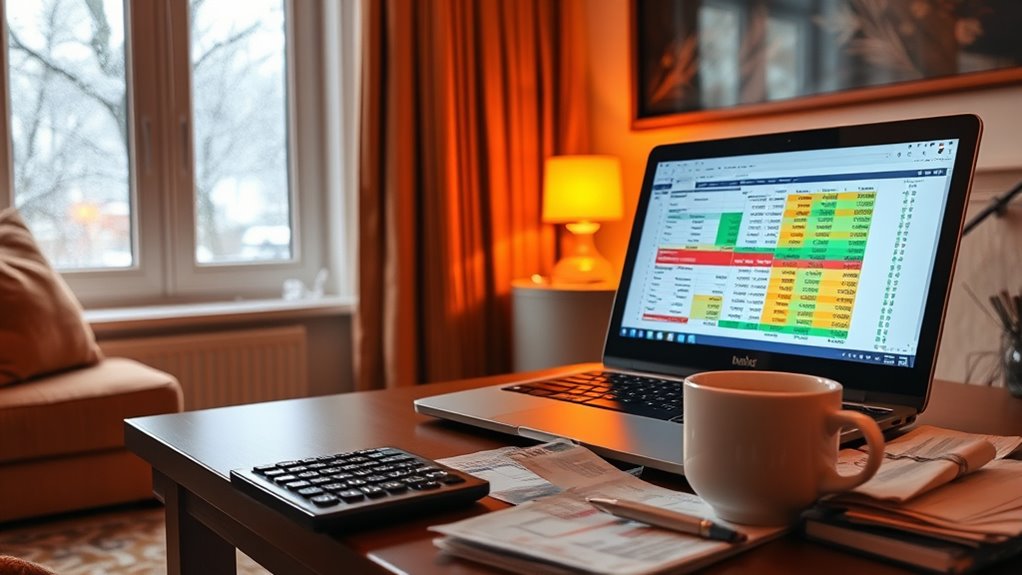To budget for rising utility bills this winter, start by reviewing your recent bills to understand your typical expenses and spot patterns. Set a realistic budget that accounts for seasonal increases and potential changes in your household. Prioritize energy-efficient habits like sealing leaks, lowering thermostats, and using programmable thermostats. Track your consumption regularly, explore assistance programs, and compare provider plans for better rates. Staying proactive helps keep costs manageable—continue on to learn more tips for winter utility savings.
Key Takeaways
- Review recent utility bills to establish a winter-specific budget based on seasonal usage patterns.
- Compare provider plans and consider switching to fixed-rate or bundled options for cost savings.
- Implement energy-efficient practices like sealing drafts and using programmable thermostats to reduce consumption.
- Track utility usage regularly to identify waste and adjust habits for better affordability.
- Explore assistance programs or rebates for energy upgrades to offset increased winter expenses.
Assessing Your Current Utility Spending

To effectively prepare for rising utility bills, you need to start by evaluating your current utility spending. Gather your recent bills for electricity, gas, water, and heating to see where your money goes each month. Look for patterns and identify the biggest expenses. Are your bills higher during certain seasons? Do you notice any unusual spikes? Tracking these details helps you understand your baseline costs and spot areas where you might cut back. Consider using a spreadsheet or budgeting app to organize this data. Knowing your typical spending gives you a clear picture of what’s normal and what could be reduced. This step is vital for making informed decisions later and setting realistic goals to manage upcoming increases effectively. Additionally, organizing and decluttering your utility-related items can help you identify unused or unnecessary appliances that may be contributing to higher bills. Understanding the cost factors involved in utility usage can also enable you to implement targeted savings strategies. Being aware of energy consumption patterns can further assist in optimizing your usage and reducing costs over time. Adopting a more efficient lifestyle by making small adjustments can significantly impact your overall utility expenses and promote sustainable habits. Cultivating a mindful approach to utility consumption can encourage more conscious and efficient habits, leading to long-term savings.
Setting a Realistic Winter Budget

With a clear understanding of your current utility spending, you’re ready to set a realistic winter budget. Begin by reviewing your recent bills and noting average monthly costs for heating, electricity, and water. Adjust these figures to account for seasonal increases, typically higher in winter. Consider any upcoming changes, such as new appliances or increased usage. Set a cap that’s slightly above your current average but still manageable within your overall household budget. Be honest about your consumption habits and avoid overestimating. Remember, the goal is to create a plan you can stick to, not to set an impossible target. Tracking your expenses regularly will help you stay on course and make adjustments as needed throughout the season. Additionally, understanding utility bill accuracy can help you identify potential discrepancies or errors in your utility billing, ensuring accuracy and avoiding overcharges. Being aware of Kia Tuning options can also inspire ways to improve your vehicle’s efficiency and potentially reduce fuel costs during the winter months. Incorporating behavioral energy conservation strategies can further enhance your ability to manage utility costs effectively. Regularly reviewing energy-efficient appliances can also contribute to lowering your utility bills over time.
Prioritizing Essential Utilities

To make the most of your utility budget, focus on heating efficiency by sealing drafts and maintaining your system. Limit water usage by fixing leaks and taking shorter showers, saving both water and money. Additionally, adjust your power consumption by turning off unused devices and switching to energy-efficient appliances. Incorporating insulation techniques can further improve heat retention and reduce overall energy costs during the colder months. Understanding the history of energy-efficient systems can help you make informed choices for sustainable home improvements. Knowing about headphones can also help you enjoy audio without increasing energy consumption, especially with wireless options that can conserve power. Additionally, protecting your smart home devices with ethical hacking principles can ensure your home’s security and privacy.
Focus on Heating Efficiency
As utility bills continue to climb, focusing on heating efficiency becomes essential for reducing overall costs. Start by sealing leaks around doors, windows, and vents to prevent heat from escaping. Installing a programmable thermostat allows you to lower temperatures when you’re asleep or away, saving energy without sacrificing comfort. Regularly maintain your heating system—clean filters and scheduled inspections ensure it runs efficiently. Consider upgrading to a high-efficiency furnace or boiler if your current system is outdated; it may have a higher upfront cost but will cut heating expenses long-term. Use curtains to insulate windows at night and open them during the day to let in natural warmth. Additionally, many modern heat pumps incorporate noise reduction technology, making them quieter and more comfortable to operate, especially during extended winter use. Proper insulation and thermal efficiency techniques further enhance your home’s ability to retain heat, significantly reducing your utility expenses. Incorporating energy-efficient appliances can also contribute to overall savings, as they often include advanced performance metrics. These simple steps can make a significant difference in your winter utility bills.
Limit Water Usage
Reducing water usage not only lowers your utility bills but also conserves an essential resource. To cut costs, start by fixing leaks promptly—they can waste gallons daily. Take shorter showers and turn off the tap while brushing your teeth. Use full loads for dishwashers and laundry to maximize efficiency. Install low-flow showerheads and aerators on faucets to reduce flow without sacrificing comfort. Be mindful of outdoor water use; water your lawn early in the morning or late at night to minimize evaporation. Collect rainwater for outdoor plants when possible. These small changes can considerably decrease your water consumption, helping you save money during the colder months while supporting conservation efforts. Regularly check for leaks and monitor your water meter to track water usage effectively. Incorporating water conservation techniques can further enhance your efforts. Practicing efficient water management ensures your household stays functional without unnecessary waste.
Adjust Power Consumption
Adjusting your power consumption is essential for managing rising utility bills, especially when you focus on prioritizing essential utilities. Start by identifying which appliances and devices are necessary, such as heating, refrigeration, and lighting in key areas. Use energy-efficient bulbs and turn off lights when not in use. Reduce unnecessary device usage by unplugging chargers and electronics that aren’t needed. Set your thermostat lower or higher depending on the season to save energy without sacrificing comfort. Consider using timers or smart plugs to control when devices operate. Limit the use of high-energy appliances like clothes dryers and ovens during peak hours. By consciously managing your power use, you can lower your bills while still ensuring your essential utilities keep your household comfortable and functional.
Implementing Energy-Saving Techniques

Implementing energy-saving techniques can substantially lower your utility bills, especially when prices are rising. Simple actions like sealing drafts around windows and doors prevent heat loss, reducing your heating needs. Use programmable thermostats to lower temperatures when you’re not home or asleep, saving energy without sacrificing comfort. Switch to energy-efficient LED bulbs, which consume less electricity and last longer. Regularly maintain your heating system to ensure it runs efficiently, avoiding unnecessary energy waste. Consider using power strips to easily turn off multiple devices when not in use, preventing phantom loads. Additionally, layering clothing and using thermal curtains can keep your home warmer without increasing heating costs. These small adjustments add up, helping you cut costs and manage your winter utility bills more effectively.
Monitoring and Adjusting Your Usage

To save money on utilities, you need to keep a close eye on your consumption. Regularly tracking your usage helps you spot patterns and identify where you can cut back. By adjusting your habits accordingly, you can better manage rising bills and stay within your budget.
Track Consumption Regularly
Monitoring your utility usage regularly is essential to understanding how your habits impact your bills. By tracking your consumption, you can identify patterns and pinpoint areas where you might be wasting energy. Use your utility provider’s online tools or smart meters to check your usage daily or weekly. Keep a record to spot trends, like increased usage during certain times or appliances that consume more power. This awareness helps you make informed decisions and avoid surprises on your bill. Regular monitoring also allows you to quickly catch any unusual spikes, which could indicate leaks, faulty appliances, or other issues. Staying on top of your consumption empowers you to take control and adjust your habits before costs spiral out of control.
Implement Usage Strategies
Once you’ve tracked your utility consumption and identified patterns, the next step is to actively adjust your usage to save energy and reduce costs. Start by setting specific goals, like lowering heating or water usage during peak times. Use programmable thermostats to maintain consistent temperatures and avoid unnecessary heating when you’re away or asleep. Seal leaks around windows and doors to prevent heat loss. Turn off lights and appliances when not in use, and consider energy-efficient replacements. Take shorter showers and run dishwashers and laundry machines with full loads. Regularly review your utility bills to spot unusual spikes or trends. By consciously managing your consumption, you can make a significant impact on your winter utility costs and stay within your budget.
Exploring Incentives and Assistance Programs

As utility costs continue to rise, exploring available incentives and assistance programs can considerably ease your financial burden. Many states and local agencies offer grants, rebates, or low-interest loans to help offset heating and electricity expenses. Check if you qualify for programs like the Low-Income Home Energy Assistance Program (LIHEAP), which provides emergency aid during peak winter months. Utility companies often have their own assistance plans, payment extensions, or budget billing options that can make bills more predictable. Additionally, some programs encourage energy-efficient upgrades, offering discounts or rebates for insulation, efficient heating systems, or smart thermostats. Take the time to research these options and apply early, as funding can be limited. Utilizing these programs can help you stay warm without sacrificing your financial stability.
Comparing Utility Providers and Plans

Have you compared different utility providers and plans recently? If not, now’s the time. Shopping around can help you find better rates and services tailored to your needs. Start by reviewing your current plan’s details, including rates, fees, and contract terms. Then, research other providers in your area—many offer online tools to compare plans side-by-side. Look for plans with fixed rates or discounts for bundling services, which can save you money long-term. Don’t forget to check customer reviews about reliability and customer service. Switching providers might seem intimidating, but it can substantially reduce your winter bills. Remember, choosing the right plan isn’t just about the lowest price—it’s about finding the most reliable, cost-effective option for your household.
Preparing for Unexpected Cost Increases

While comparing utility providers helps you lock in the best rates, unexpected increases can still catch you off guard. To prepare, create a flexible budget that accounts for potential spikes in your bills. Set aside an emergency fund specifically for utility costs, so you’re not caught off guard if prices rise suddenly. Keep track of your typical usage patterns and look for signs of increases, like higher-than-normal bills. Consider signing up for alerts from your utility company to stay informed about rate changes. Also, stay informed about seasonal factors or policy updates that might impact your rates. Planning ahead guarantees you’re ready for any surprises, helping you maintain financial stability even when utility costs unexpectedly increase.
Tips for Maintaining Comfort on a Budget

Staying comfortable at home doesn’t have to mean high utility bills. Start by sealing drafts around windows and doors to keep heat in. Use weatherstripping or caulking to prevent heat loss. Layer your clothing and use blankets to stay warm without turning up the thermostat. Lower your thermostat a few degrees; each degree can save you money. Maximize sunlight during the day by opening curtains, then close them at night to insulate. Consider using a programmable thermostat to set back your heat when you’re away or asleep. Maintain your heating system with regular filters and inspections for efficiency. Small changes like these help you stay cozy without draining your wallet, making winter more affordable and comfortable.
Frequently Asked Questions
How Can I Accurately Track My Utility Usage Over Time?
To accurately track your utility usage over time, start by reviewing your monthly bills carefully. Keep a detailed log of your consumption, noting any significant changes. Use smart meters or energy-monitoring devices if available, which give real-time data. Set reminders to record your readings regularly, such as weekly or bi-weekly. This way, you’ll identify patterns, detect issues early, and make informed decisions to manage your utility costs effectively.
What Are the Most Cost-Effective Energy-Efficient Appliances?
Ever wonder which appliances save you the most money? You’ll want to look for ENERGY STAR-rated appliances—they use less energy without sacrificing performance. Think about upgrading your refrigerator, washer, or water heater; these often have the biggest impact on your bills. By choosing energy-efficient options, you not only cut costs but also help the environment. Start with small upgrades, and watch your savings grow while your home stays comfortable.
How Do Weather Changes Impact My Utility Bills?
Weather changes directly impact your utility bills because colder temperatures make you use more heating, increasing your energy costs. Conversely, warmer weather reduces heating needs but may raise cooling expenses. Sudden cold snaps or heatwaves can cause spikes in usage. To save money, you should adjust your thermostat accordingly, seal leaks, and use energy-efficient appliances to minimize the effect of weather fluctuations on your bills.
Are There Specific Habits That Significantly Reduce Utility Consumption?
Imagine your home as a fortress, where small habits can keep it warm and efficient. You can turn down your thermostat a few degrees, wear cozy clothes indoors, and unplug devices when not in use. These actions make a big difference, reducing your utility bills. Regularly sealing gaps and using energy-efficient bulbs also help. By adopting these habits, you actively cut costs and stay comfortable all winter long.
How Can I Negotiate Better Rates With My Utility Provider?
You want to negotiate better rates with your utility provider, and you can. Start by reviewing your current usage and bills to identify areas for improvement. Call customer service and ask about available plans or discounts, especially for long-term customers. Be polite, confident, and prepared to discuss your usage patterns. Sometimes, providers offer special rates or incentives to retain customers, so don’t hesitate to explore those options.
Conclusion
By taking these steps, you’ll turn the formidable mountain of rising utility bills into a manageable hill. Stay vigilant, adapt your habits, and explore all available options—your efforts can save you enough to buy a small island someday! Remember, a little planning now can make your winter cozy and affordable, so don’t let those soaring bills catch you off guard. Stay proactive and keep your utility costs under control all season long!









